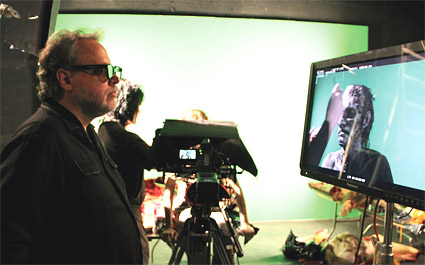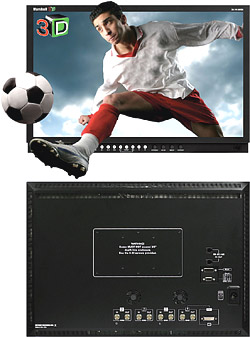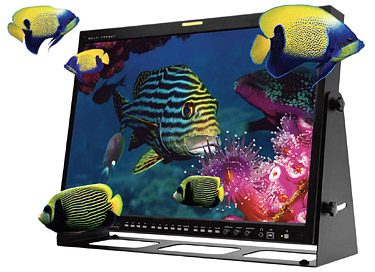3D Monitors Put Video in Perspective

Standing on a green-screen stage while shooting “Night of the Living Dead 3D: Re-Animation” is the film’s director, Jeff Broadstreet. Broadstreet is viewing a Panasonic 3DL2550 monitor.
ALEXANDRIA, VA.—After a burst of excitement spurred by the film "Avatar," interest in 3D production has continued despite a limited home audience. 3DTVs for the home have been available for three years, but have not been adopted nearly as quickly as 2D flatpanel TVs in the wake of the digital conversion at high-power TV stations.
There are factors that may help popularize 3D home viewing, such as the recent introduction of user-friendly cellphones that can shoot 3D video in HD—video that can then be viewed on a 3DTV. The bottom line for many video producers is that if there is an audience, there needs to be content for that audience to watch. That means there will continue to be a need for 3D production equipment, such as monitors.
IN THE STUDIO
Several manufacturers build professional 3D monitors for production and studio monitoring applications, including Panasonic. Jeff Blauvelt of HD Cinema in Los Angeles works on productions using Panasonic's 3DL2550 25-inch monitors and has come to value the display's features that speed the shooting process.
"There is a nice overlay grid feature that shows six-percent spacing," Baluvelt said. "While three-percent disparity is still often too much, you can interpolate and at a glance see how much divergence you have with objects in the field of view."
HD Cinema uses a wide range of acquisition gear, and Blauvelt appreciates how the 3DL2550 supports video from just about anything.
"The monitor has a built in flip function, and re-times the non-flipped image so you can use the monitor with beamsplitter mirror [camera] rigs," he said.

Marshall Electronics 3D-241-HDSDI full resolution 24-inch stereoscopic 3D LC D monitor with HD-SDI One of the other interesting features of the Panasonic 3DL2550 is that the monitor can display a color space that is 102 percent of the NTSC standard, exceeding the EBU/SMPTE range displayed by most LCD monitors. Even CRT monitors don't have the color accuracy to provide this level of chroma reproduction.
The JVC GD-463D10 is a 46-inch monitor that best serves as the program display in a control room or for audience monitoring. The GD-463D10 uses Xpol circular polarization that lets the monitor display the left- and right-eye images simultaneously, which reduces flicker. This works particularly well for images with fast motion.
The GD-463D10 has two 3D video formats: line-by-line format and side-by-side. Line-by-line format scans left and right images in the even and odd lines of an interlaced video signal. In side-by-side format, left and right images each use 1/2 of the display, shown on the left and right sides of the screen.
For field monitoring, Transvideo has a range of rugged 3D monitors small enough to go on a body rig and large enough to work as a producer's monitor. The Transvideo CineMonitorHD8 3DView Evolution is an eight-inch display with fittings that can attach to a variety of camera support gear.
One of the features that makes the CineMonitorHD8 3DView Evolution popular for field production is that it is available with an optional virtual horizon that helps the camera operator keep the image level. Each unit also comes with a manual describing the theory and basics of 3D-steroscopic shooting, written by French stereographer Alain Derobe.
TVLogic is just now coming out with its first 3D monitor, the TDM-243W, a 24-inch display built for both studio and field production, with an all metal chassis and multiple mounting options.

TV Logic TDM -243W 24-inch 3D display Although there are a wide variety of professional and consumer 3D monitors available from several manufacturers, not all are created equal when it comes time to do serious 3D production.
"You want to look for a 3D monitor that has accurate calibrated color in both 2D and 3D modes, plus useful tools for 3D production like split-screen, disparity simulation and horopter check," said Wes Dixon, TV Logic's director of communications.
HOLY GRAIL
The Holy Grail of 3D monitors is a viewing experience that doesn't involve glasses of any kind. That's available today on a couple of cell phones and some other consumer displays, and now Marshall Electronics has introduced the Orchid OR-70-3D, a seven-inch 3D monitor that can be viewed without glasses.
Targeted at 3D camera operators, cinematographers and content producers, the Orchid OR-70-3D is claimed to be the world's first autostereoscopic 3D (glasses-free) seven-inch portable production monitor.
"Marshall continues to support the growth and expansion of global 3D production," said Mark Fisher, marketing director for Marshall Electronics. "The OR-70-3D is now the most versatile and technologically advanced 3D monitoring solution available to filmmakers and content producers."
Miracube has both 3D monitors and projection systems, including displays for general monitoring as well as camera-mounted viewfinders. The Miracube G240R is a 24-inch 3D display that supports frame-sequential, side-by-side, top/bottom and interlaced formats, and it can be switched to 2D operation at the push of a button. The G240R has a claimed viewing angle (in 2D mode) of 178 degrees.
For camera-rig mounting, Miracube has the 10-inch VF-101P, a lightweight display with a carrying handle on top, as well as a synchronizer for combining two feeds into one 3D movie file.
As the price for 3D cameras drifts down, and as editing systems increasingly add support for 3D post-production, 3D will creep into more production operations for projects big and small. It is impossible to produce 3D without a monitor on which to view it, and the choice of monitor has an impact on how you will be able to complete the production.
For those of you who are now comfortable working with HD, this is a great time to research 3D production tools, such as monitors.
Bob Kovacs is a television engineer and video producer. He can be reached at bob@bobkovacs.com.
Get the TV Tech Newsletter
The professional video industry's #1 source for news, trends and product and tech information. Sign up below.
Bob Kovacs is the former Technology Editor for TV Tech and editor of Government Video. He is a long-time video engineer and writer, who now works as a video producer for a government agency. In 2020, Kovacs won several awards as the editor and co-producer of the short film "Rendezvous."

